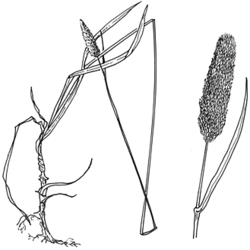Common Name: Phalaris, canary grasses

Description: Tufted or rhizomatous annuals or perennials.
Leaves with ligule membranous, truncate; blade rolled in bud, flat.
Inflorescence a stiff, dense, ovoid to cylindrical, sometimes interrupted, panicle.
Spikelets shortly pedicellate, solitary or in clusters, laterally compressed, rachilla disarticulating above the glumes; florets 2 or 3, the lower 1 or 2 sterile (or rarely male), and the uppermost bisexual. Glumes equal, strongly keeled, often winged on the keel, longer than the lemmas, 3–5-nerved with the nerves often green and conspicuous. Sterile lemmas membranous, often reduced, 1 sometimes absent. Fertile lemmas unawned, acute, hairy or glabrous, often shining. Palea a little shorter but similar to the lemma.
Distribution and occurrence: World: c. 20 species, chiefly Europe, with 1 species in America. Australia: 9 species (naturalized), all States except N.T.
One pasture species, Phalaris aquatica, is widespread in eastern temperate areas. Key after Vickery (1975).
Text by S. W. L. Jacobs & S. M. Hastings
Taxon concept:
| | Key to the species | |
| 1 | Spikelets in groups of 5–7, with male or sterile spikelets and sometimes sterile branches surrounding 1 or more spikelets with bisexual florets, the group falling together at maturity; fertile lemma glabrous | 2 |
| Spikelets all alike (reduced spikelets sometimes found at the base of the panicle) each with a bisexual floret, the glumes persistent on each pedicel at maturity; fertile lemma pubescent | 3 |
| 2 | Perennials with swollen stem bases; spikelet groups usually with more than 1 fertile spikelet; wing on glumes with several small teeth at the apex; pedicels glabrous | Phalaris coerulescens |
| Annuals without swollen stem bases; spikelet groups with 1 fertile spikelet surrounded by reduced spikelets or club-shaped sterile branches; wing on glumes with 1 prominent tooth near the apex; pedicels hairy
Back to 1 | Phalaris paradoxa |
| 3 | Sterile lemmas 2, equal or subequal and well developed | 4 |
| Only 1 sterile lemma well-developed, if 2 present then these very unequal
Back to 1 | 6 |
| 4 | Sterile lemmas more than 50% as long as the fertile floret, rather broad, not subulate; glumes with a broad, entire wing widest in the upper 30%, tapering abruptly to the apex | Phalaris canariensis |
| Sterile lemmas narrow, subulate, usually less than 50% as long as the fertile lemma; wing on glumes narrower
Back to 3 | 5 |
| 5 | Perennials with long rhizomes; panicle often rather loose, interrupted or lobed; glumes acute or acuminate, usually wingless; sterile lemmas uniformly hairy above the scale-like bases | Phalaris arundinacea |
| Annual without rhizomes; panicle dense, cylindrical; glumes obtuse or abruptly acute, keel narrowly winged; sterile lemmas glabrous above basal hairs
Back to 4 | Phalaris angusta |
| 6 | Perennial with stem bases often tuberous, forming dense clumps; glumes winged in the upper 50–70%, wing margins entire, tapering more gradually towards the base than the apex; lower sterile lemma absent or reduced to a scale-like base | Phalaris aquatica |
| Annual without tuberous stem bases and not forming dense clumps; wing on glumes widest c. 30% below apex, usually erose or finely toothed, tapering equally towards both base and apex; lowest lemma usually absent
Back to 3 | Phalaris minor |
|


